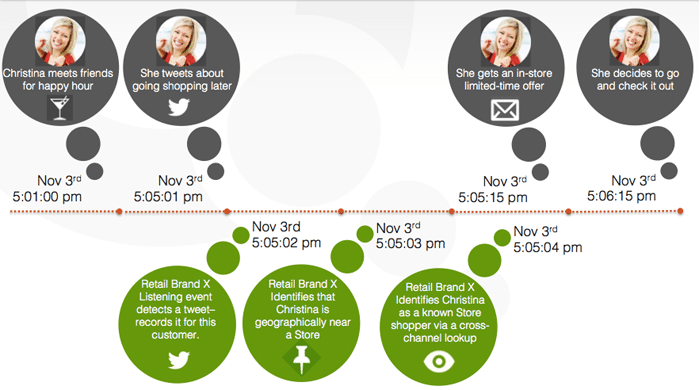In today’s multichannel marketplace, consumers choose their time and place to research and buy. They continuously change their buying habits, and they have no tolerance for brands that do not deliver what they want, when they want it, wherever they are. Nearly half of all consumers say the best thing retailers can do to improve their shopping experience is better integration of shopping channels, while 89% say more choice of those channels is crucial. (Accenture)
If you want to be a successful marketer, you need to adopt an effective social listening strategy that allows you to communicate with your customers on their preferred channels, in ways that are timely and driven by both interest and convenience.
But how do successful brands do social listening right? Here are five steps that you can take to ensure you have the agility and flexibility needed to design perfectly timed and individually tailored messages that will keep pace with today’s customers on their multichannel buying journeys.
1. Clear Your Decks for Action: Establish the cleanest possible contact data mart.
Todays’ primary marketing challenge is a data challenge. Too many merchants have complex data, organizational silos, multiple vendors, and no consolidated, real-time view of the results of outbound and inbound campaigns. And setting this data challenge in the context of the multiple channels consumers now navigate makes it very challenging for marketers to promote singular, omnichannel relationships and keep the attention of the modern consumer.
No matter whether you’re starting small, with no database, a handful of disconnected lists, and a simple welcome program, or you’re managing dozens of consolidated data sources, outbound and inbound channels, and millions of customers in a consolidated and highly secure data mart, you need the cleanest possible prospect and customer data. Your ability to engage in real-time campaign optimization for maximum impact and marketing ROI will depend on it.
2. Listen for Triggers: Use both explicit and implicit/structured and unstructured posts across social platforms (online and on mobile devices) to reveal, identify and entice new and existing customers.
In order to treat customers and prospects as individuals at every stage along the buying journey, you need to listen for the interactions, opinions, and aspirations of your customers in real time across all channels. Listen to the social posts offered by prospective customers at different points along the buying journey; they can yield important clues to their receptiveness to timely incentives from friendly brands. These “triggers” can help you learn, adapt, and pivot to drive continuous value to the customer before, during, and after a purchase.
Here’s how a savvy retail brand can engage influential consumers. In this not-so-hypothetical example, Retail Brand X actively listens for, detects, records and actions offers based on explicit triggers initiated by customer Tara.
 3. Learn about Each Customer’s Behavior: Extract the signals to identify patterns of loyalty, intention and interest.
3. Learn about Each Customer’s Behavior: Extract the signals to identify patterns of loyalty, intention and interest.
The buying journey is a continuum. Each customer interaction along the way leaves behind a small but important digital breadcrumb trail. The challenge for the successful marketer is finding and following that trail. This may include large, structured data like your ecommerce system or other operational data stores. But it also may involve fast-moving data like transactional streams from your POS systems, and unstructured or “big-data” that might be buried in call center chat logs, Twitter streams or traffic and weather feeds. You need to listen to your customer’s interactions with your brand and follow the customer’s trail if you want to make that next touch the right one for the customer.
A singular trigger picked up in isolation isn’t enough to learn each customer’s behavior and predict or influence future action at any given moment. You need to follow the trail and unearth patterns in order to build dynamic, personalized customer segments that will maximize your marketing ROI.
4. Personalize your Customer’s Journey: Revolutionize your data collection and analytics approaches.
Sophisticated data collection and analytics approaches are critical to building complex and accurate customer segments and accessing real-time, running customer counts across key segments. You need to be able to integrate all customer touch points, inbound feeds, and outbound campaign results with a multichannel outbound publishing and delivery capability. Get it wrong, and you’re sure to alienate your customer with irrelevant content. But get it right, and you’re far more likely to win hearts and wallets, as the illustration below shows.
In this scenario, Retail Brand X picks up a geolocation-based trigger from a mobile device, identifying shopper Christina and recognizing that she is in proximity to Brand X’s store. Brand X is able to offer Christina a time-sensitive incentive to entice her to buy.
5. Optimize in Real Time: Use dynamic campaign development and optimization tools. Superior campaign development tools for today’s market can combine and visualize data to help you make better, faster decisions about campaign performance, customer trends, and segments. Visualization lets you learn more about all of your buyers including first time purchasers, repeat customers, lapsed buyers, and your most valuable customers. By segmenting buyers based on complex behaviors, you can adapt and pivot your programs in real time and anticipate future trends so your next campaign moves at the speed of your always-on, social, mobile customers.
If you are equipped to listen to your customer in real time across all channels, you can make better decisions about how to treat and engage that customer. If you can quickly design and deploy life cycle programs while still being able to react and engage the customer in the moment, you can influence that customer with just the right message. And if you can learn, adapt, and pivot to drive continuous value to the customer before, during, and after a purchase, you can deliver what the customer wants, when they want it, wherever they are.
Mike Shanker is the CEO and co-founder of QuickPivot.
